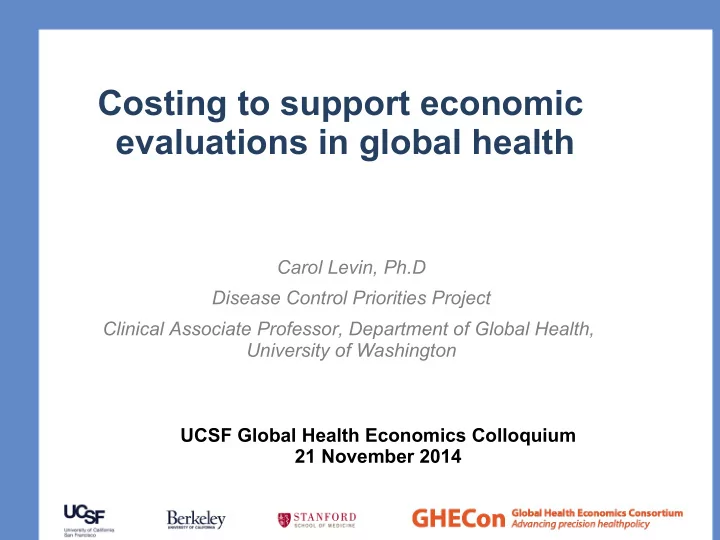

Costing to support economic evaluations in global health Carol Levin, Ph.D Disease Control Priorities Project Clinical Associate Professor, Department of Global Health, University of Washington UCSF Global Health Economics Colloquium 21 November 2014
Interest is high 2 11/25 /14
Multiple uses for cost data Priority setting for new interventions or Resource requirements and introducing new advocacy technologies, drugs, vaccines Financial planning Improving technical and budgeting efficiency
DCP Literature reviews • Searches completed for economic evaluations (costs, CEA) • RMNCH – Reproductive health and family planning – Maternal, Child and Neonatal health and nutrition – PMTCT • Non-communicable disease – CVD, diabetes, respiratory – Cancers (Breast, cervical, pediatric, liver, colon) – Mental Health • Essential Surgery
Inclusion criteria • Type of evaluation – Partial economic evaluation • Includes only costing data – Full economic evaluation: • Includes both costs and effectiveness • Only keep if it has good cost data • Measurement/Study Type – Must have either or both: • Unit costs • Cost of intervention • Includes direct costs, or both direct and direct non-medical – Focus on costs of implementing the interventions – Treatment costs • Only English articles
By the numbers: Article retrieval and unit cost extraction Mental Process Surgery CVD RMNCH Health Total 1504 3809 518 818 8452 articles 7907 1398 678 3628 433 Excluded 545 33 181 85 Text 140 assessed 125 160 21 69 39 Included studies 253 Cost data 468 132 185 Points
Increase in number of studies over time Reproductive, Cardiovascular and maternal, neonatal respiratory cost and child health studies &!" ,-./,010203"452670" %#" ,8-91"4:60" %!" ;-<=><?" ;6@@<?"A0:9"03@"B8291?23" $#" 452670" C0=3"4D?2670"03@" E0226.?03" $!" A-28>?"03@"E?3920<"4:60" A0:9?23"4:60"03@"F076G7" #" !" %!!!" %!!$" %!!%" %!!&" %!!'" %!!#" %!!(" %!!)" %!!*" %!!+" %!$!" %!$$" %!$%" %!$&" %!$'" ! Growing body of literature in low and middle income countries
So what’s the problem? • Depends on your perspective. • Donor “Do we need more cost studies?” – Can’t we use the data we have? • Researchers “We need better data” – Moving toward more expensive studies – Larger samples sizes to improve precision, accuracy and robustness. • Decision makers “We need information today” • WHO “Let’s build a sustainable system for routine cost collection.” 8 11/25 /14
Challenges • Many estimates of program costs are inadequate and of mixed quality. • Relevant data are sometimes absent, are not locally relevant, are not quality adjusted, or are available from a limited perspective (e.g. the payers), do not capture full system costs, and fail to capture variations in cost by delivery strategy/platform. • There are no validated methods for projecting costs from one setting to others. • Very little standard methods or reporting for costing studies – Multiplicity of ways to estimate costs – Little attention by authors to quality check lists for costs, although they do exist. – Little reporting on discount rate, whether tradable or non-tradable • Scarce or absent published literature for interventions to address adolescents, maternal depression, care and care practices, gender based violence. • Limited packages of interventions estimated using costing tools
Variability in costs: example: Reproductive and maternal health costs !"#$%&'()*"+,-&+.,/"$-,0+1",0/2+3%4/4+5-+6%78+,-&+.5&&0"8 9-(%:"+3%'-/$5"4+;<=>+?@A?B+ &'()*+(!&,-).-/!01()!('(/23! 456!&,-).-/!01()!('(/23! 7(89:*;!&,-).-/!01()!('(/23! 7<&!&,-).-/!01()!('(/23! =->2?&,-).-/!6*)(!01()!('(/23! 6(>*)(*/!@(:.-/!01()!8(;9'()A3! <*+9/*;!4(;9'()A!01()!8(;9'()A3! 4(;9'()A!6-B1;9:*.-/>!01()!8(;9'()A3! C*B9;A!=;*//9/+!01()!A(*)!-D!1)-2(:.-/3! !"#!! !"$!! !"$#!! !"$##!! !"$%###!! !"$#%###!! 7(89*/!6->2! 79/9BEB!F!7*G9BEB!6->2! 10 11/25 /14
Lack of cost data for low capacity settings: RMNCH cost data for Ethiopia 11 11/25 /14
Why does it matter? Consequences • Countries and donors often do not know the correct cost estimates to use in financial planning, resource allocation and budgeting. – resources are misallocated and health benefits are foregone. • Over time, efficiency improvements cannot be measured. • Donors, funders and National Finance Ministries cannot assess whether they are getting value for their money, and cannot provide effective incentives for greater efficiency.
Actions to improve costing • Development of a reference case for economic evaluation in low-resource settings • Development of a global health costing consortium 13 11/25 /14
Disease Control Priorities Network DCP – DGH Team Dean Jamison – Principal Investigator Rachel Nugent – Project Director Carol Levin - Senior Research Scientist Stephane Verguet – Acting Assistant Professor Brie Adderley – Project Coordinator Zach Olson– Health Economics Analyst, now at UC Berkeley *** Partners: PHFI, CGHR, UQ, IOM, World Bank, WHO Acknowledgements to UCSF, LSHTM, INSP and the Futures Institute.
Contact : clevin@uw.edu THANK YOU!
Recommend
More recommend